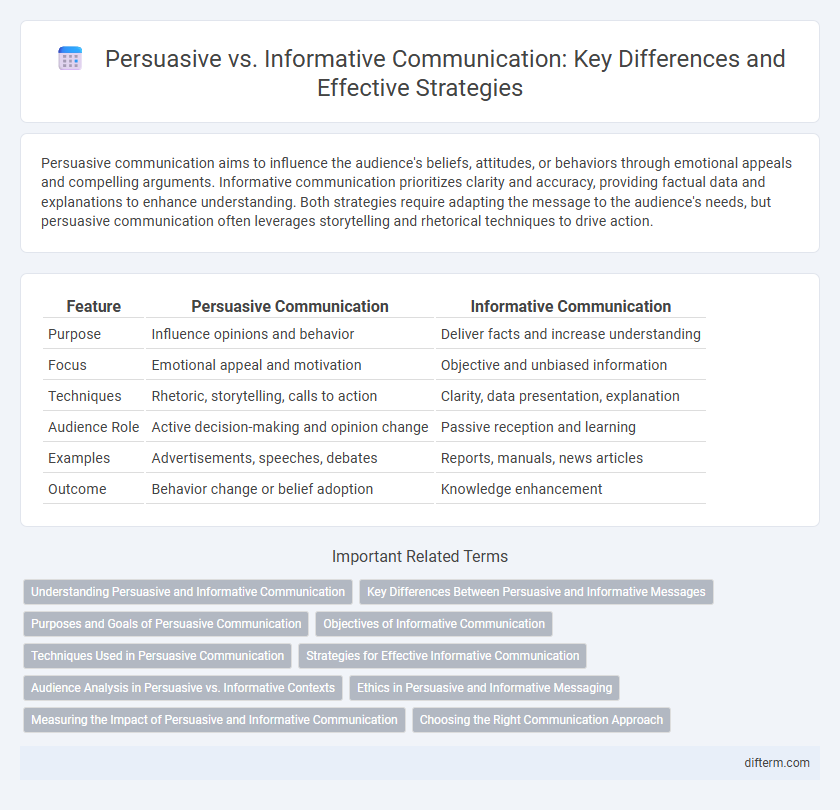Persuasive communication aims to influence the audience's beliefs, attitudes, or behaviors through emotional appeals and compelling arguments. Informative communication prioritizes clarity and accuracy, providing factual data and explanations to enhance understanding. Both strategies require adapting the message to the audience's needs, but persuasive communication often leverages storytelling and rhetorical techniques to drive action.
Table of Comparison
| Feature | Persuasive Communication | Informative Communication |
|---|---|---|
| Purpose | Influence opinions and behavior | Deliver facts and increase understanding |
| Focus | Emotional appeal and motivation | Objective and unbiased information |
| Techniques | Rhetoric, storytelling, calls to action | Clarity, data presentation, explanation |
| Audience Role | Active decision-making and opinion change | Passive reception and learning |
| Examples | Advertisements, speeches, debates | Reports, manuals, news articles |
| Outcome | Behavior change or belief adoption | Knowledge enhancement |
Understanding Persuasive and Informative Communication
Persuasive communication aims to influence attitudes, beliefs, or behaviors by appealing to emotions, logic, and credibility, often utilizing rhetorical strategies and compelling evidence. Informative communication focuses on delivering clear, accurate, and objective facts to enhance knowledge and understanding without attempting to change opinions. Effective communicators differentiate these approaches to tailor messages that either motivate action or provide essential information.
Key Differences Between Persuasive and Informative Messages
Persuasive messages aim to influence the audience's attitudes, beliefs, or behaviors by appealing to emotions, values, and logic, often using calls to action and persuasive techniques like storytelling or social proof. Informative messages prioritize delivering clear, accurate, and unbiased facts or instructions to increase understanding without attempting to change opinions or prompt immediate responses. The key difference lies in intent: persuasion seeks to motivate change, while informative communication focuses on educating and clarifying.
Purposes and Goals of Persuasive Communication
Persuasive communication aims to influence attitudes, beliefs, or behaviors by appealing to emotions, logic, and credibility, often seeking to motivate action or change opinions. Its primary purpose is to convince the audience to adopt a specific viewpoint, make decisions, or take a particular course of action. Unlike informative communication that focuses on delivering facts or knowledge, persuasive communication strategically integrates rhetorical techniques to achieve desired behavioral outcomes.
Objectives of Informative Communication
Informative communication aims to increase audience knowledge by presenting clear, accurate, and relevant facts without attempting to influence opinions or behaviors. The objective is to enhance understanding and enable informed decision-making through unbiased data delivery. This type of communication prioritizes clarity, transparency, and factual accuracy to ensure content is comprehensible and trustworthy.
Techniques Used in Persuasive Communication
Persuasive communication employs techniques such as emotional appeals, repetition, and storytelling to influence attitudes and behavior effectively. Utilizing ethos, pathos, and logos enhances credibility, evokes emotions, and presents logical arguments that resonate with the audience. Strategic use of rhetorical questions and vivid imagery further strengthens the persuasive impact by engaging listeners on multiple cognitive levels.
Strategies for Effective Informative Communication
Effective informative communication relies on clarity, organization, and accuracy to ensure the audience fully comprehends the message. Utilizing visual aids, concrete examples, and concise language enhances understanding and retention of information. Structuring content logically and anticipating audience questions fosters engagement and minimizes misinterpretation.
Audience Analysis in Persuasive vs. Informative Contexts
Audience analysis in persuasive communication targets influencing beliefs by identifying values, attitudes, and emotional triggers, enabling tailored messages that motivate behavioral change. In informative contexts, the focus shifts to assessing the audience's prior knowledge and cognitive capacity to ensure clarity, comprehension, and retention of factual content. Understanding these distinct audience characteristics optimizes message effectiveness in achieving either persuasion or information dissemination goals.
Ethics in Persuasive and Informative Messaging
Ethics in persuasive messaging demand honesty, transparency, and respect for the audience's autonomy to avoid manipulation or deception. Informative messaging prioritizes accuracy, clarity, and completeness to ensure the receiver gains a truthful understanding without bias. Both approaches must uphold ethical standards to maintain trust and credibility in communication.
Measuring the Impact of Persuasive and Informative Communication
Measuring the impact of persuasive communication involves evaluating changes in audience attitudes, beliefs, and behaviors, often using tools like surveys, focus groups, and behavioral analytics to assess effectiveness. Informative communication impact is typically measured by assessing knowledge retention, comprehension, and the accuracy of information recall through quizzes, feedback forms, and comprehension assessments. Both methods rely on quantitative and qualitative metrics to determine how well the message achieves its intended purpose, ensuring clarity and influence are appropriately gauged.
Choosing the Right Communication Approach
Choosing the right communication approach depends on the purpose: persuasive communication aims to influence attitudes or behaviors through emotional appeal and logical arguments, while informative communication focuses on delivering clear, factual, and unbiased information to enhance understanding. Effective communicators assess their audience's needs, context, and desired outcome to determine whether persuasion or information sharing is most appropriate. Tailoring the message to align with these factors maximizes engagement and achieves communication goals.
persuasive vs informative Infographic

 difterm.com
difterm.com